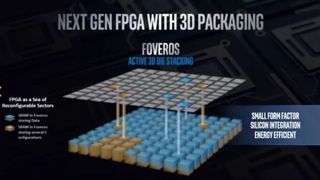Intel's Sunny Cove Architecture: What You Need to Know
Intel revealed the direction it's taking to right the ship after facing crippling delays with its 10 nanometer CPUs.
At an Architecture Day event in Santa Clara, company executives spoke about the technique being used to develop future processors. Chief among those is what Intel calls Foveros, a new 3D packaging technology in which processors are stacked on top of each other. The idea is to shorten the distance between electric signals, thereby improving power consumption and performance.

Credit: Intel
The technique allows Intel to match different dies -- CPUs, GPUs, and Ai processors -- to create an efficient system-on-a-chip (SOC). Intel showed off a functioning Foveros chip with a 10nm CPU and an I/O chip, reports our sister site Tom's Hardware.
The most pressing concern for Intel is solving its 10nm nightmare. The company has fumbled for years to produce smaller processing nodes, specifically reducing the current 14nm chipsets down to 10nm. The 10nm chips, codenamed Ice Lake, were scheduled for mass production in 2018, but Intel was forced to delay the release after running into yield issues.
To appease the forming mobs, Intel re-released 14nm processors with higher clock speeds, and, therefore, small performance boosts. There now appears to be a light at the end of the tunnel. Intel introduced a new microarchitecture called Sunny Cove, which is based on a 10nm manufacturing process. The architecture should enable overall performance gains, reduced latency and allow for more processes to be simultaneously executed.

Credit: Intel
Stay in the know with Laptop Mag
Get our in-depth reviews, helpful tips, great deals, and the biggest news stories delivered to your inbox.
Sunny Cove will arrive on Core and Atom processors in the latter half of 2019. Intel hasn't clarified whether Sunny Cove would first arrive on Ice Lake chips. The company published a new roadmap for its next-generation CPU platforms. Sunny Cove will be followed by Willow Cove, which will debut in 2020 with improved caching and more security features. In 2021, Intel is expected to release a Golden Cove microarchitecture with a focus on performance and AI. Atom CPUs will similarly coincide with microarchitecture releases of Tremont in 2019, Gracemont in 2021 and "Next" Mont in 2023.
Intel also showed off a new Gen11 integrated graphics engine that will provide the backbone for upcoming integrated graphics units. According to Tom's Hardware's Paul Alcorn, a demo of the 10nm processor using Gen11 graphics ran Tekken 7 "amazingly well." Along with reducing memory demands, the new architecture will support multiple 4K and 8K video streams and provide up to 30 percent bitrate reduction with hurting image quality compared to the Gen9 microarchitecture. These are the first integrated graphics expected to reach a teraflop of performance, which means you should expect upcoming ultrabooks to run modern games at higher frame rates.

Credit: Intel
Intel also teased the upcoming Xe architecture that will follow Gen11. It will mark a shift from integrated graphics to the upcoming discrete GPUs that Intel announced earlier this year. Intel is targeting a 2020 release for Xe-based graphics cards.
Cover Image: Intel
Phillip Tracy is the assistant managing editor at Laptop Mag where he reviews laptops, phones and other gadgets while covering the latest industry news. After graduating with a journalism degree from the University of Texas at Austin, Phillip became a tech reporter at the Daily Dot. There, he wrote reviews for a range of gadgets and covered everything from social media trends to cybersecurity. Prior to that, he wrote for RCR Wireless News covering 5G and IoT. When he's not tinkering with devices, you can find Phillip playing video games, reading, traveling or watching soccer.
